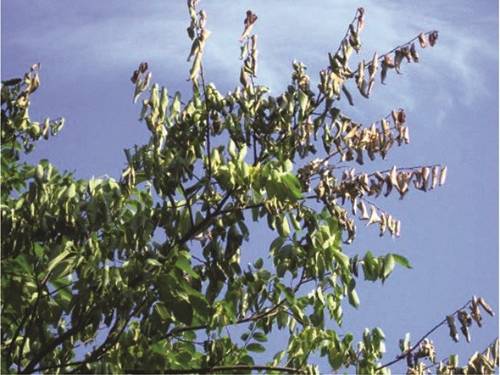Dutch Elm Disease

The disease has been present in the United States since the 1920s, when it rapidly spread across elm populations, killing most American elms. Every year, the disease spreads and kills more elm trees, including red elm, rock elm, and cedar elm.
Dutch elm disease (DED) blocks water-conducting tissue within the tree, causing discolored and wilted foliage. These initial symptoms often appear in late May but can also appear in late August or September. The trees become infected by insect vectors. Typically, here in Kansas, it is the European elm bark beetle. The beetle typically feeds at the top of the tree at the crown, so wilt symptoms often appear on small branches. Wilt and discoloration can appear in trees for many reasons, but if the tree is afflicted with DED, the wilt will continue to progress throughout the tree within weeks or months until the tree dies. Trees may live up to one year after becoming infected with DED.
Although affected branches are often high up in the tree, if you could take a sample of a branch in that area, you could see dark brown streaks under the bark. These long, brown-to-red streaks will run the length of the branch in contrast to the creamy color of healthy elm wood. Dead branches will not show these symptoms. If you can obtain a sample and see this streaking, contact your local extension office to discuss testing the samples.
An incredibly cool feature of elms that has worked against them with DED is the ability of tree roots to fuse to those of their neighboring elms. Elms fuse their roots with neighboring elm trees to share a standard root system. This fusing is likely if elm trees are within 50 feet of one another. For this reason, when a single tree becomes infected with DED, the fungus can move down the roots into nearby trees. Sanitation is critical for the control of Dutch elm disease. Homeowners should identify and remove dead or dying elm trees, even the resistant elms, Siberian and Chinese. The wood from these trees should be hastily buried, burned, or chipped. Beetles that spread DED can overwinter in firewood and emerge in April, so wood should be quickly burned and not stored for long periods.
Using fungicides as a preventative and therapeutic control of DED is possible, but a certified arborist should use such products. These treatments are expensive and should only be done for specimen trees of high value.
Here are a few elms that are resistant to DED to replace those that have died:
- Frontier Elm (Ulmus ‘Frontier’): Hybrid of carpinifolia and U. parvifolia. This tree is resistant to the leaf beetle and has good heat and drought resistance. New growth is red/purple with a burgundy fall color.
- Vanguard Elm (Ulmus ‘Morton Plainsman’): This tree is a hybrid of U. japonica and U. pumila. It has an upright vase shape with waxy, lustrous leaves.
- Lacebark Elm (Ulmus parvifolia): Excellent, tough, versatile shade tree with few pests and good resistance to Dutch elm disease and leaf beetles. The bark is the most desirable feature. Notable cultivars include: Athena Elm, Allee Elm, Emerald Prairie, and Bosque Elm.
- Prospector Elm (Ulmus wilsoniana ‘Prospector’): This tree has a broad vase shape with dark-green leaves. Good resistance to Dutch elm disease, elm yellows, and elm leaf beetles.
Additional information about DED, including trenching and selective pruning to slow the spread, can be found online: https://hnr.k-state.edu/extension/info-center/common-pest-problems/common-pestproblem-new/elm-dutch-disease.pdf

Have questions? Contact our office where our Horticulture Extension Agent will assist you with questions.
Phone: (316) 321-9660
Email: callae@ksu.edu